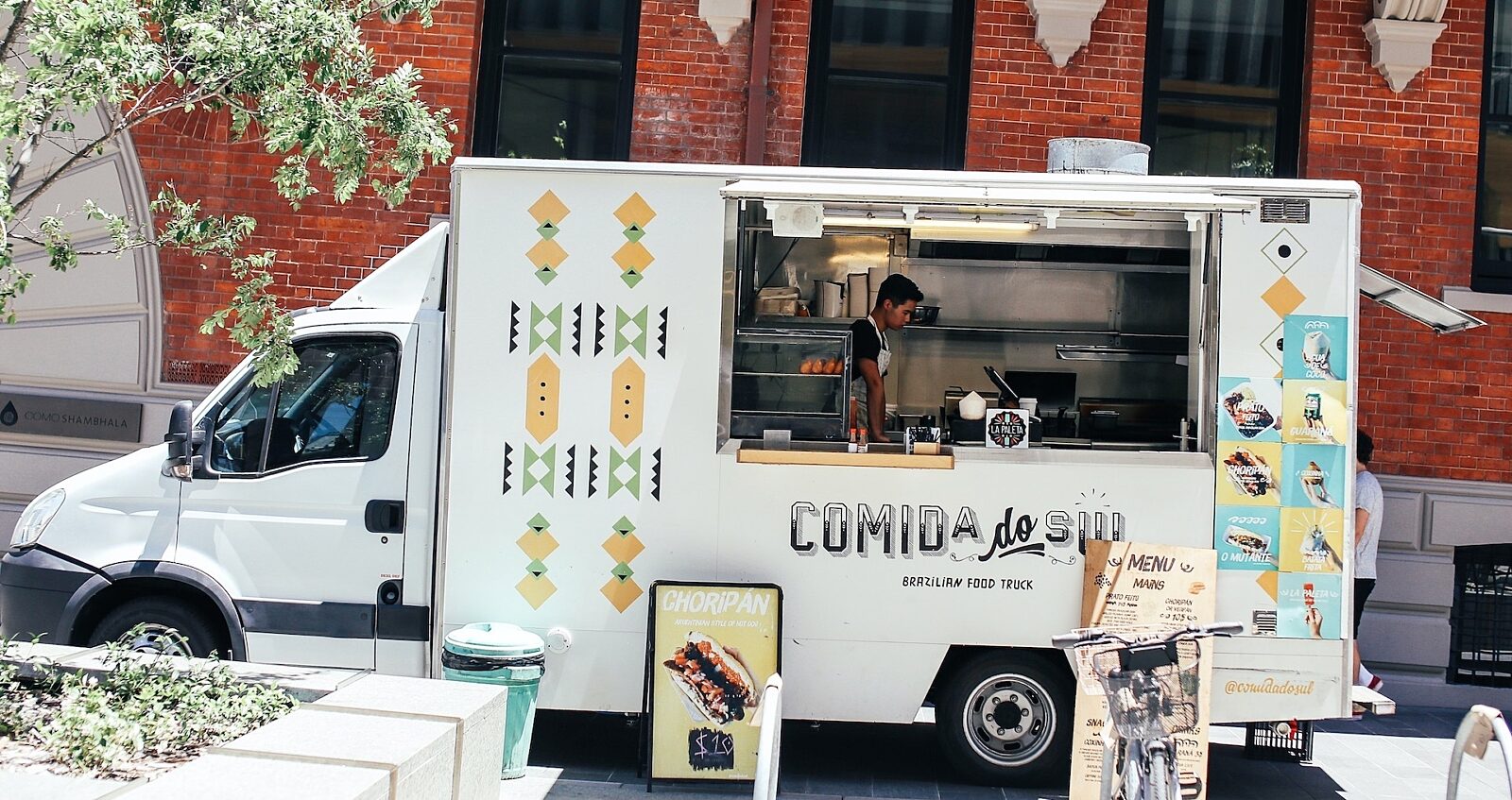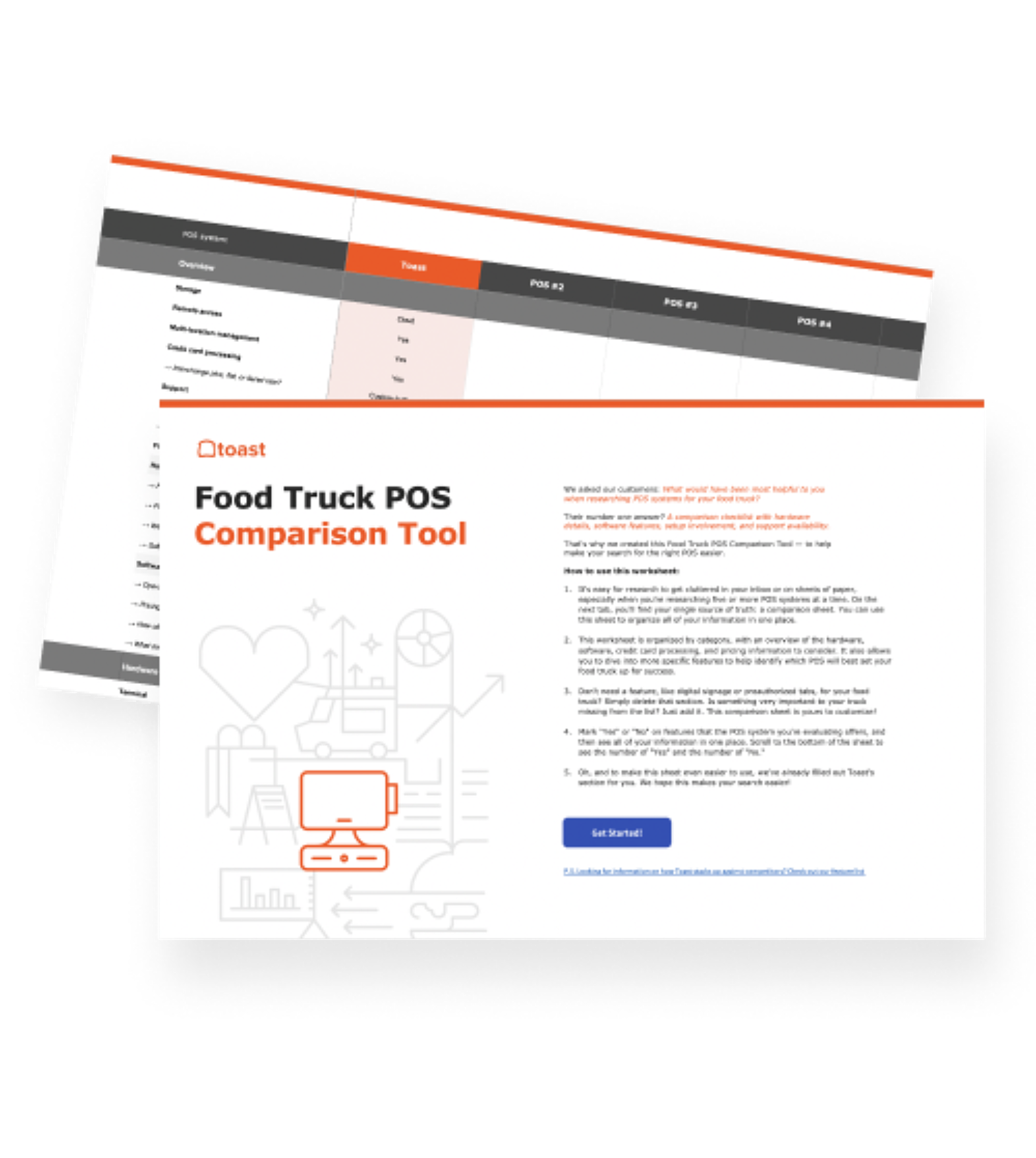
How Much Do Food Trucks Make?
Food trucks can make up to $500,000 a year, but how much would yours make? Calculate (and maximize!) your food truck’s revenue potential.
Tyler MartinezAuthor


Food Truck POS Comparison Tool
A free, customizable Food Truck POS Comparison Tool to research and compare point of sale systems in one Excel spreadsheet or editable PDF.
Get free downloadHow Much Do Food Trucks Make? (Food Truck Profit Margin)
Food trucks make an average of $250,000-$500,000 annually, or $20,000 - $42,000 monthly. That might seem like a big range – so this guide will help you to calculate your food truck’s revenue and profit margin potential.
Along the way, you’ll develop some strategies for maximizing your restaurant’s income.
Restaurant Profit Margin Calculator
Use this free Restaurant Profit Margin Calculator to see how efficiently you turn sales dollars into profits.

Costs to Start a Food Truck
While food trucks are flexible businesses, the start-up costs can still range from $50,000 - $250,000. You’ll need to factor in all the essentials of the restaurant industry, such as labor, goods, insurance, and marketing,
There are some food truck-specific expenses as well. The truck, necessary licenses, permits, and equipment to outfit your mobile kitchen are all necessities. You might also need to factor in the costs of a commercial kitchen and permits for parking.
Are Food Trucks Profitable?
Startup costs for equipment, the truck, kitchen space, and licenses make the first year of business especially important – and costly. In addition to all the first-time expenses, it’s crucial to account for the monthly expenses of your first year of operation. Consider the financing requirements of your first year of business carefully.
Contingency funds help your first year or so run smoothly until your food truck becomes profitable. Have liquid assets in the form of a personal loan or savings to pay for staff and unforeseen expenses. Even the best food trucks aren’t immune to Murphy’s law.
- Startup - $50,000- $275,000
- Equipment - $50,000-$200,000
- Permits/licenses - $500-1500
- Contingency Funds - $20,000 - $250,000
Average Food Truck Costs
The monthly expenses of operating a food truck will total 85-90% of your monthly sales once the business becomes profitable. For your first year or more, you might have to keep investing to make up for losses in labor, food costs, or marketing. While you can deliver great food and service, the proper financial plans solidify your food truck’s long-term success.
- Operating Costs $13,000 - $65,000
- Commercial Kitchen - $1,500/month
- Parking - $500-$1,000/month
- Insurance - $500-$8,000/month
- Utilities - $1,000-$1,200/month
- Marketing - $500- $5,000 (3-6%) of sales
- Food Costs $5,000-$25,000 (30-35% of sales)
- Labor $2,500-$25,000 (24-40% of sales)
- Loan Repayment
Forecasting Your Food Truck’s Sales
Use sales data such as labor, food costs, inventory, and capacity to forecast your food truck’s sales. Without sales history, it is difficult to calculate how your restaurant will grow from month to month in the first year. Consider factors like the seasonal peaks in your area, your marketing reach, and other key performance indicators (KPIs).
First, calculate your daily capacity. For a food truck, consider how many customers you have the capacity to serve – how many kebabs and salads you and your staff can produce – during a shift. Then, based on the food costs and profits of those items, you can calculate how much you have the potential to make during a shift.
Of course, you won’t be working at capacity every shift. If you have sales data from a month (or even a week), you can view the average sales from each of those nights with the proper restaurant point of sale technology, and calculate the average for each shift.
Average Food Truck Revenue
The national average of food truck revenue – the total sales before expenses – is $20,000-$42,000 monthly. Once you forecast your sales, you can get a more accurate number for your food truck. To calculate your food truck’s average monthly revenue, add your projected sales from each month (which should vary in consideration of KPIs) and divide that number by the number of months in your season.
Food Truck Profit Margin Per Month
A restaurant’s profit margin is typically between 3%-5%, but some make as little as 0% and others as much as 15%. Calculate your profit margin with the following equation: monthly sales x profit margin = profit. If your food truck averages $40,000/month in sales, and the profit margin is 4%, the profit is $1,600.
Food Truck Owner’s Salary
Once the business becomes profitable, then you can think about taking a salary. Nationally, food truck owners make between $24,000 and $153,000 per year. Typically, the owner’s salary for a food truck is less than 50% of the profit.
In a small food truck, your salary might be a higher percent of your profit, relative to how much labor you put into the business. If your role is executive chef, accountant, and occasional line cook, you’ll be able to afford to pay yourself a higher percentage than if you spend most of your time managing teams.
As the owner, you’ll have to make tough decisions about how much to pay yourself while investing profits into the growth of the business. The first year can be especially daunting, but improving your sales with marketing and technology will put your food truck on the road to success.
Timeline for Breaking Even for Food Truck
Most food trucks can expect to become profitable within the first year and a half to two years, depending on the food costs and your businesses’ and region's KPIs.
You’ll have to work to ensure that your food truck becomes profitable before you spend through your contingency funds and financing. Now that you have a full picture of how to forecast your food truck’s revenue, you can estimate how long it will take for your business to break even – meaning, to have its first profitable month against startup and operating costs.
Are you planning to follow a local festival circuit or does your town fill with tourists every July? Use these KPIs to determine when you can expect boosts in sales. Then, calculate how much you’ll have to make in sales before your truck – all the startup and operating costs – have been paid. Consider the example below as you conduct your calculations:
Lou’s Chicken Truck of New Orleans starts with a loan of $350,000, with a repayment period of 5 years at 5.6% interest:
Equipment (including the Truck): $100,000
Permits & Licences: $1,000
Contingency Funds: $249,000
Lou’s Chicken Truck saves on labor because Lou works a lot of the shifts herself in the first year and a half of business; however, her parking budget is high because it is costly to park at New Orleans’ many festivals.
Commercial Kitchen Rental: $1,500
Parking: $900
Insurance: $2,200
Utilities: $1,000
Food Costs: $9,000
Labor: $3,000
Marketing: $1,500
Loan payment: $4,400
Total: $25,500
At $25,500, the annual cost of operating Lou’s Chicken Truck is $306,600.
Lou’s famous chicken sandwich, her bestseller, nets her $6.75 in profit. She offers french fries or red beans and rice as sides – the fries profit $1.50 and the beans $3.50. If she and her team can make 150 chicken sandwiches per shift, they can profit $1,012.50. If they sell fries with a third of the orders and red beans with another third, they add $206.25 in revenue per shift. At 100% capacity, Lou’s Chicken Truck can make $7,312.5 in a 6 shift week.
Monthly Sales: $29,062
Operating Expenses: $25,500
Profit: $3,750
Profit Margin at 100% capacity: 8.8%
At an average of 50% capacity, Lou’s Chicken Truck can potentially gross $143,403 annually (50% of the gross profit potential x 52 weeks), with monthly revenue of $11,950. That rises to $286,806 annually at %100 capacity.
- The startup costs of Lou’s chicken sandwich truck were $451,000 and the monthly operating costs are $25,500. Lou’s first year will cost $467,500.
- Lou’s operates at 50% capacity for the first three months – $43,593
- Lou’s had a great second quarter (it was festival season in New Orleans) and operated at 70-85% capacity for that quarter – about $65,398 in total revenue.
- They kept the momentum going past festival season, operating at 60-70% capacity in quarter 3, earning an additional $56,607.90.
- New Orleans is a saturated market and fiercely competitive, so Lou’s is back to 50-60% in quarter 4, and ends the year with $47,952.30 in revenue.
- Lou’s earns $213,551.20 in revenue for the year.
- Luckily, Lou’s contingency funds let her stay afloat this year, making up the $262,949 shortfall.
Lou’s food truck must operate at an average of 87% capacity to be profitable. If the owner sets the proper groundwork with marketing and good record keeping, the business should become profitable before the end of the second year.
Improving Your Food Truck’s Sales
There are concrete steps business owners can take to improve their sales and the timeline to profitability. Calculate food costs carefully and train employees to upsell your highest-profit items. You might even design your menu to highlight those items for guests. Get permits to park your truck at events and festivals to find customers and introduce your brand to locals.
Marketing your food truck with a website and social media pages is a necessity in today’s digital world. Ensure that your customers can find your truck with an active online marketing strategy.
The Right Tech
The technology that runs your food truck empowers you to maximize efficiency and profitability. Set your business up for success by utilizing inventory, time-tracking, and financial software from the outset. Invest in a POS system that brings it all into one place. When you’re ready to scale up, the right technology keeps the business organized and your growth on track.
Related Food Truck Resources
- How Much Does it Cost to Start a Food Truck
- How to Start a Food Truck Business
- Best Food Truck Ideas
- Food Truck POS System
- Food Truck Name Ideas
- Food Truck Equipment
- Food Truck Design Ideas
- Food Truck Websites
- Food Truck Marketing Ideas
- Food Truck Menu Ideas
- How to Do Food Truck Branding
- Food Truck Business Plan Template
- Food Truck Design Ideas
- Food Truck Licenses and Permits
- Best Food Truck POS Systems
- Food Truck Supplies
Is this article helpful?
DISCLAIMER: This information is provided for general informational purposes only, and publication does not constitute an endorsement. Toast does not warrant the accuracy or completeness of any information, text, graphics, links, or other items contained within this content. Toast does not guarantee you will achieve any specific results if you follow any advice herein. It may be advisable for you to consult with a professional such as a lawyer, accountant, or business advisor for advice specific to your situation.
Read More
Subscribe to On the Line
Sign up to get industry intel, advice, tools, and honest takes from real people tackling their restaurants’ greatest challenges.



